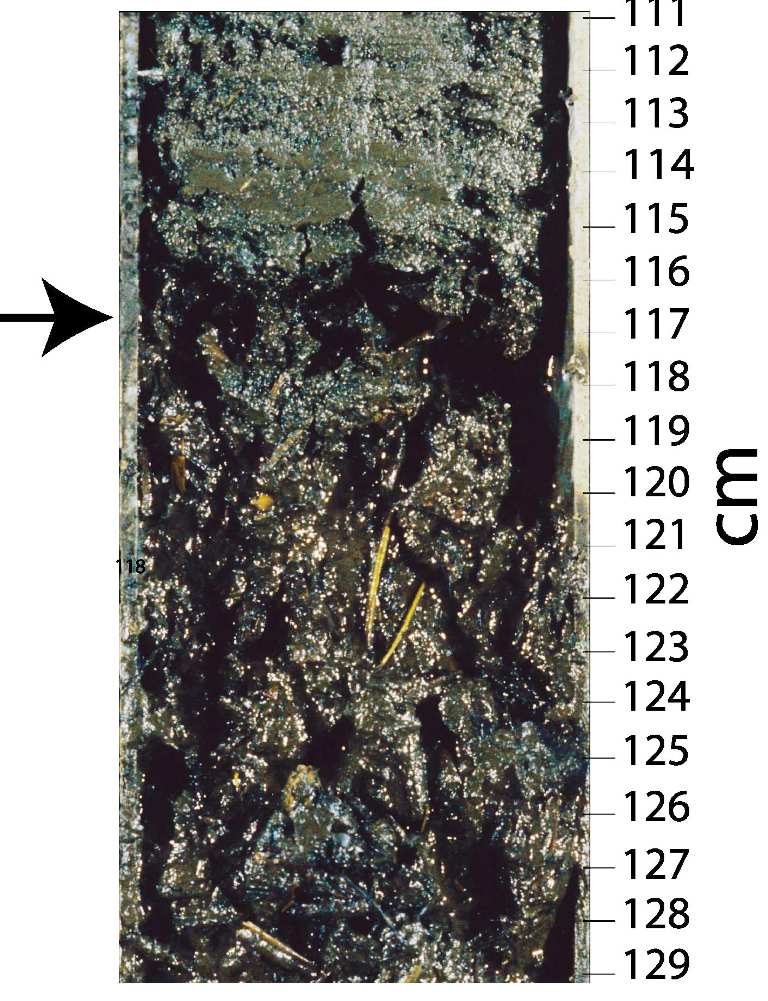

Below the sharp contact at about 117 cm (black arrow),
we observe sediments and heterogeneous material Probable formation of the Lake Cheko in 1908
such as vegetation macro-remnants and wood fragments mixed in the lacustrine sediments.
X-ray radiography and photo images of core TG-22 show an upper 80 cm zone of finely laminated sediments, underlain by a non-stratified chaotic unit, with a 40-cm thick transition zone of homogeneous deposits containing coarser grained sediments, vegetation macro-remnants (herbs and larch cones) and wood fragments in the lower part of the core. High-resolution seismic reflection profiles imaged two sedimentary units below the lake floor, i.e., a 0.5–1 m thick finely laminated lacustrine unit overlaying a chaotic/massive lower unit. We assume that the two units identified in the core correspond to the two units revealed by the acoustic reflection data throughout the deeper part of the lake. Using radiometric data to define their age and depositional environment we concluded that the core TG-22 sequence can be subdivided into an upper, post-TE interval from ∼80 cm to the top, and a lower, pre TE interval from ∼120 cm down to the bottom of the core, with a transitional zone from 80 to ∼120-cm depth. The estimated average deposition rate during the last century is ∼1 cm yr−1.
Lake’s sediments are generally dark brown-blackish in colour. They have high contents of organic matter and water, and fine grain size, ranging from fine-sand to mud. The sediment mainly consists of sandy-mud (mud fraction ranges from 50% to 83% d.w.); the sand content increases in the lower unit ranging from 25% to 60%. Lower and upper units are separated by a ‘transitional zone’ (between 80 and 120 cm) that shows sub-horizontal layering and is constituted by coarser-grained sediments (from silt to fine-sand); the contact between lower unit and transitional zone is sharp. Deposits from the lower, pre-TE section appear to be coarser than those from the upper, post-TE interval, in line with the hypothesis that the lower section is made of reworked river sediments, deposited from a relatively high-energy system capable of transporting coarser grains. In contrast, the finer deposits of the upper section are compatible with deposition from a low-energy environment similar to present-day Lake Cheko.
Both organic C and N are more abundant in the upper, post-TE unit than in the lower section. The C/N ratio is rather constant in the upper sequence, while it displays high amplitude variations in the lower section. This distribution is compatible with the upper sediments having been deposited from a lake with relatively high organic productivity and deposition rates, vs. a lower section of reworked river deposits less affected by biological productivity. We can speculate that a sharp peak in both organic C and N content at the transition from the lower to the upper section may have resulted from accumulation of organic debris transported into the Cheko basin by Kimchu River after the TE devastation.
While δ15N remains about constant below and above the TE level, δ13C is a few units more negative in the upper, post-TE sequence than in the lower zone. This may reflect the presence in the upper zone of δ12C-enriched, algal material typical of lacustrine environments.
Pollen analysis confirms the presence of two different units, above and below the ∼100-cm level. The upper 100-cm long section, in addition to pollen of taiga forest trees such as Abies, Betula, Juniperus, Larix, Pinus, Picea, and Populus, contains abundant remains of hydrophytes, i.e. aquatic plants probably deposited under lacustrine conditions similar to those prevailing today. These include both free floating plants and rooted plants, growing usually in water up to 3–4 meters in depth (Callitriche, Hottonia, Lemna, Hydrocharis, Myriophyllum, Nuphar, Nymphaea, Potamogeton, Sagittaria). In contrast, the lower unit (below ∼100 cm) contains abundant forest tree pollen, but no hydrophytes, suggesting that no lake existed then, but a taiga forest growing on marshy ground. Pollen and microcharcoal show a progressive reduction in the taiga forest, from the bottom of the core upward. This reduction may have been caused by fires (two local episodes below ∼100 cm), then by the TE and the formation of the lake (between 100 and 90 cm), and again by subsequent fires (one local fire in the upper 40 cm).
The reasearches on the TG22 core have been illustrated By Rick Beyer and Bill Lattanzi (Veriscope Picture) for the "National Geographics" Channel. Here, you can download part of that video: